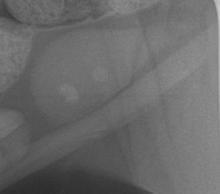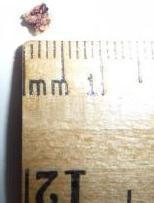Bladder Stones in Dogs and Cats
- posted: Jul. 10, 2016
 Bladder Stones in Pets
Bladder Stones in Pets
Dogs and cats who are straining to urinate, have bloody urine or are urinating frequent small amounts may have a bladder infection, but another common cause of these symptoms are stones in the bladder. People often get kidney stones, and, while pets can form stones in their kidneys, they are much less common than bladder stones. Stones irritate the bladder lining causing it to become inflamed and to bleed and most pets feel a frequent urge to urinate. Small stones may even get stuck in the urethra (the small tube that exits the bladder) especially in males potentially causing a life-threatening blockage.
Why do stones form and what are they made of? Dogs and cats can form a variety of stones, and a variety of factors contribute to stone formation including how acidic or basic the urine is, how dilute or concentrated the urine is and several genetic factors. The three most common are struvite stones composed of the minerals ammonium magnesium and phosphate, calcium oxalate stones, and urate stones. Struvite stones in dogs usually occur secondary to recurrent urinary tract infections. This is not the case with cats which form struvite stones in response to the pH, protein level and amount of water in the urine. Calcium oxalate stones form due to a hereditary defect in a substance called nephrocalcin which normally inhibits the formation of oxalate stones. Diets high in foods containing calcium like dairy products or oxalates in vegetables like spinach can also contribute to formation of these stones. Some breeds seem more likely to form bladder stones such as miniature schnauzers, shih tzus and Yorkies. Many Dalmatians also have a genetic defect that causes them to form urate stones. Urate stones may form in other breeds if they have liver disease or a condition known as a liver shunt.
How are bladder stones diagnosed? Most stones are radiopaque, meaning they show up as a bright white object on a radiograph ( x-ray) so radiographs are the most common way of diagnosing bladder stones. Once in a while, an ultrasound scan may be used to confirm a stone.
How are bladder stones treated? In most cases, surgical removal of stones is the best treatment as stones can cause chronic inflammation and may block the urethra causing serious or even life-threatening illness. Occasionally, struvite stones may dissolve if the pet is fed a special -prescription diet. Diets can be risky because we do not often know the type of stone and it can take several weeks to several months for the stone to dissolve. Oxalate stones do not dissolve and must always be surgically removed. Urate stones are usually surgically removed but dissolution of the stones may be attempted with a low purine diet and/or use of a drug called allopurinol.
How can I prevent my dog or cat from forming stones in the future? Having urine samples checked 2-4 times or more per year will help identify infections or changes in pH and concentration and reduce formation of some stones. Prescription diets designed to keep the urine pH neutral and to make dogs and cats drink more water to dilute their urine are frequently used to prevent new stones from forming. Urate stones can be controlled in Dalmatians with low purine diets and with allopurinol. Avoiding feeding your pet certain foods such as foods high in calcium or oxalates if he had calcium oxalate stones or avoiding vitamin B and vitamin C supplements in Dalmatians which affect purine metabolism can reduce formation of uric acid stones.
Bladder stones are a fairly common problem for our dogs and cats but while most pets need surgery, some stones can be treated and managed with diet and medications.
This blog brought to you by the Patton Veterinary Hospital serving Red Lion, York and the surrounding communities. 
Location
Patton Veterinary Hospital
425 E Broadway
Red Lion, PA 17356
